Taxation Law Assignment: Residency, Income, and Dividends
VerifiedAdded on 2023/03/23
|7
|1345
|75
Homework Assignment
AI Summary
This taxation law assignment solution addresses key aspects of Australian taxation, including the determination of residency based on various tests (reside, domicile, 183-day, and superannuation fund) as per ITAA 1997 and ITAA 1936. The solution analyzes the residency status of an individual, Sinclair, who worked overseas and applies the relevant tests to determine if he is an Australian resident. It also covers the taxation of income earned by Australian residents from foreign employment, citing relevant case law. Furthermore, the assignment explains the taxation of dividends for non-residents, differentiating between franked and unfranked dividends, and clarifies the implications for tax offsets and deductions. The solution also addresses the need for non-residents to declare Australian-sourced income on their tax returns. References to relevant sections of the legislation and case laws like FCT v Applegate (1979) and FCT v French (1957) are provided to support the arguments.
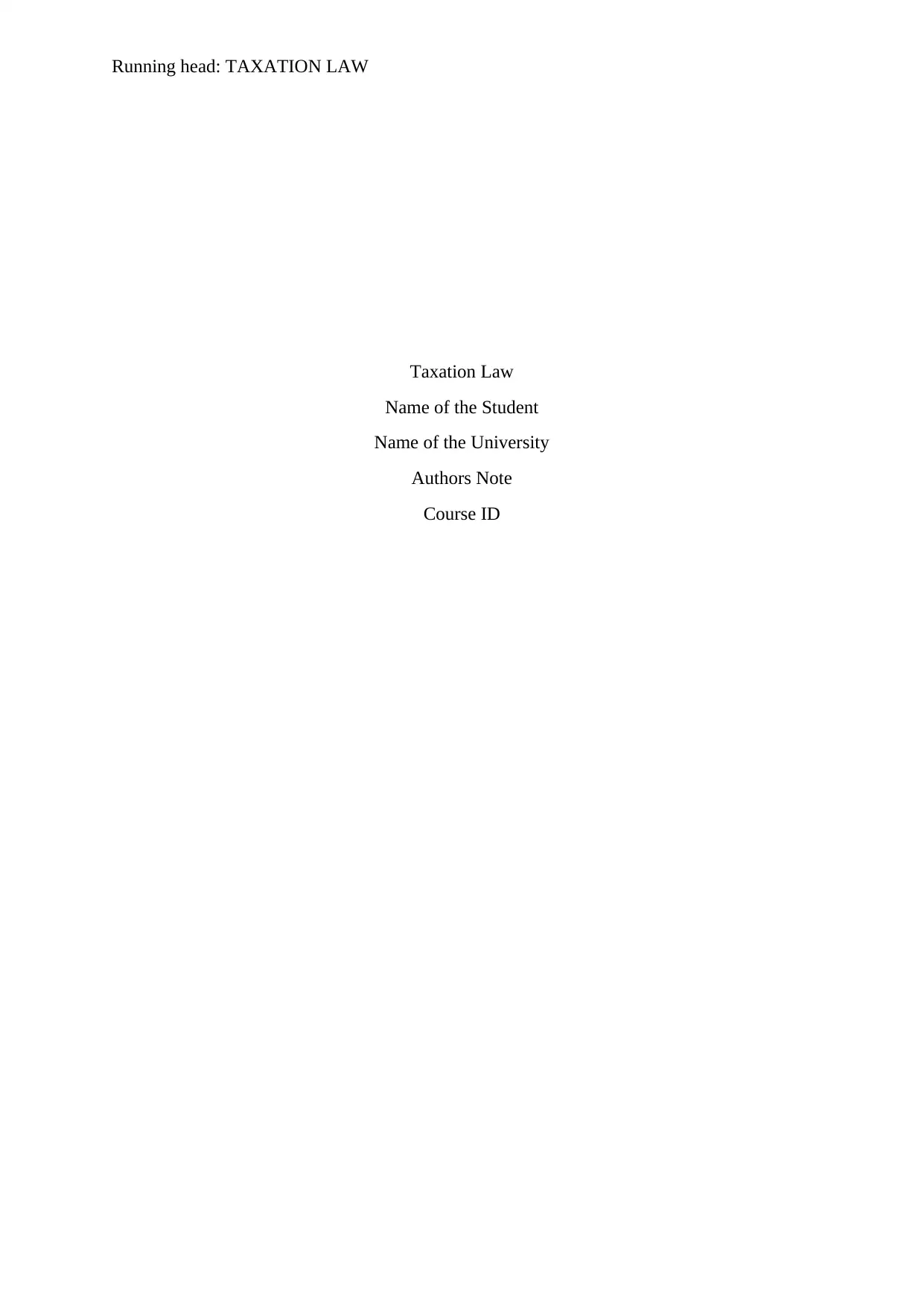
Running head: TAXATION LAW
Taxation Law
Name of the Student
Name of the University
Authors Note
Course ID
Taxation Law
Name of the Student
Name of the University
Authors Note
Course ID
Paraphrase This Document
Need a fresh take? Get an instant paraphrase of this document with our AI Paraphraser
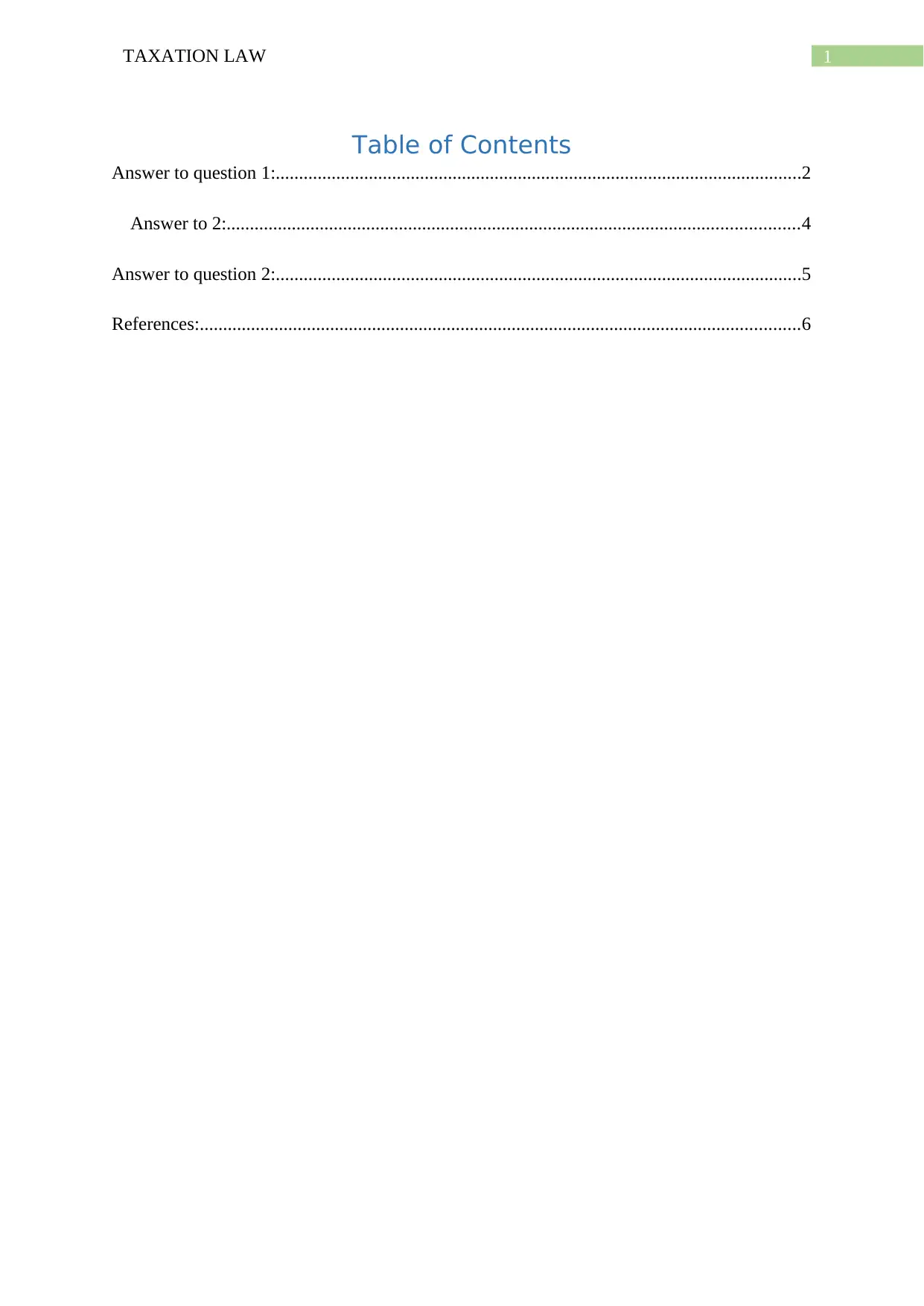
1TAXATION LAW
Table of Contents
Answer to question 1:.................................................................................................................2
Answer to 2:...........................................................................................................................4
Answer to question 2:.................................................................................................................5
References:.................................................................................................................................6
Table of Contents
Answer to question 1:.................................................................................................................2
Answer to 2:...........................................................................................................................4
Answer to question 2:.................................................................................................................5
References:.................................................................................................................................6
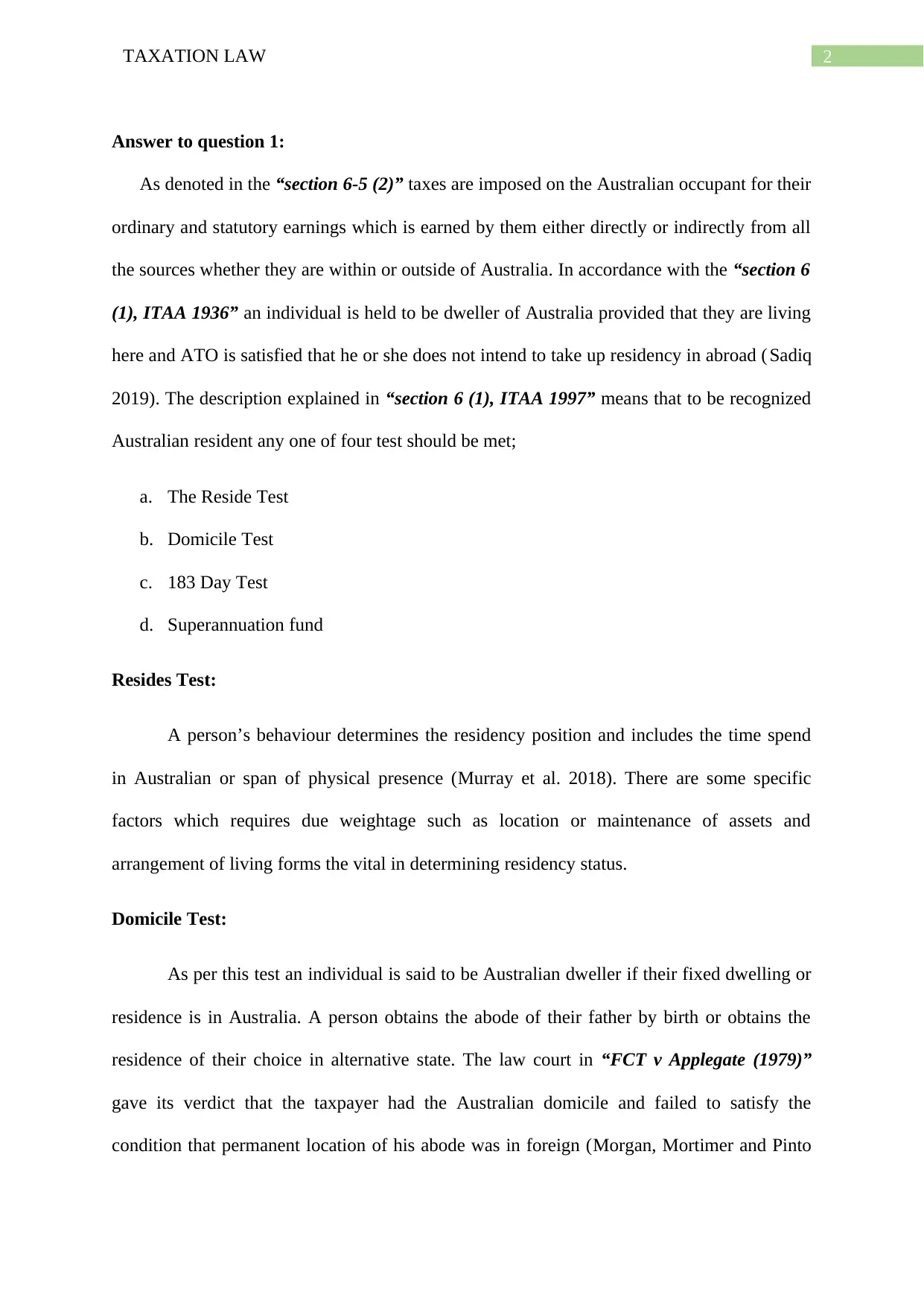
2TAXATION LAW
Answer to question 1:
As denoted in the “section 6-5 (2)” taxes are imposed on the Australian occupant for their
ordinary and statutory earnings which is earned by them either directly or indirectly from all
the sources whether they are within or outside of Australia. In accordance with the “section 6
(1), ITAA 1936” an individual is held to be dweller of Australia provided that they are living
here and ATO is satisfied that he or she does not intend to take up residency in abroad ( Sadiq
2019). The description explained in “section 6 (1), ITAA 1997” means that to be recognized
Australian resident any one of four test should be met;
a. The Reside Test
b. Domicile Test
c. 183 Day Test
d. Superannuation fund
Resides Test:
A person’s behaviour determines the residency position and includes the time spend
in Australian or span of physical presence (Murray et al. 2018). There are some specific
factors which requires due weightage such as location or maintenance of assets and
arrangement of living forms the vital in determining residency status.
Domicile Test:
As per this test an individual is said to be Australian dweller if their fixed dwelling or
residence is in Australia. A person obtains the abode of their father by birth or obtains the
residence of their choice in alternative state. The law court in “FCT v Applegate (1979)”
gave its verdict that the taxpayer had the Australian domicile and failed to satisfy the
condition that permanent location of his abode was in foreign (Morgan, Mortimer and Pinto
Answer to question 1:
As denoted in the “section 6-5 (2)” taxes are imposed on the Australian occupant for their
ordinary and statutory earnings which is earned by them either directly or indirectly from all
the sources whether they are within or outside of Australia. In accordance with the “section 6
(1), ITAA 1936” an individual is held to be dweller of Australia provided that they are living
here and ATO is satisfied that he or she does not intend to take up residency in abroad ( Sadiq
2019). The description explained in “section 6 (1), ITAA 1997” means that to be recognized
Australian resident any one of four test should be met;
a. The Reside Test
b. Domicile Test
c. 183 Day Test
d. Superannuation fund
Resides Test:
A person’s behaviour determines the residency position and includes the time spend
in Australian or span of physical presence (Murray et al. 2018). There are some specific
factors which requires due weightage such as location or maintenance of assets and
arrangement of living forms the vital in determining residency status.
Domicile Test:
As per this test an individual is said to be Australian dweller if their fixed dwelling or
residence is in Australia. A person obtains the abode of their father by birth or obtains the
residence of their choice in alternative state. The law court in “FCT v Applegate (1979)”
gave its verdict that the taxpayer had the Australian domicile and failed to satisfy the
condition that permanent location of his abode was in foreign (Morgan, Mortimer and Pinto
⊘ This is a preview!⊘
Do you want full access?
Subscribe today to unlock all pages.

Trusted by 1+ million students worldwide
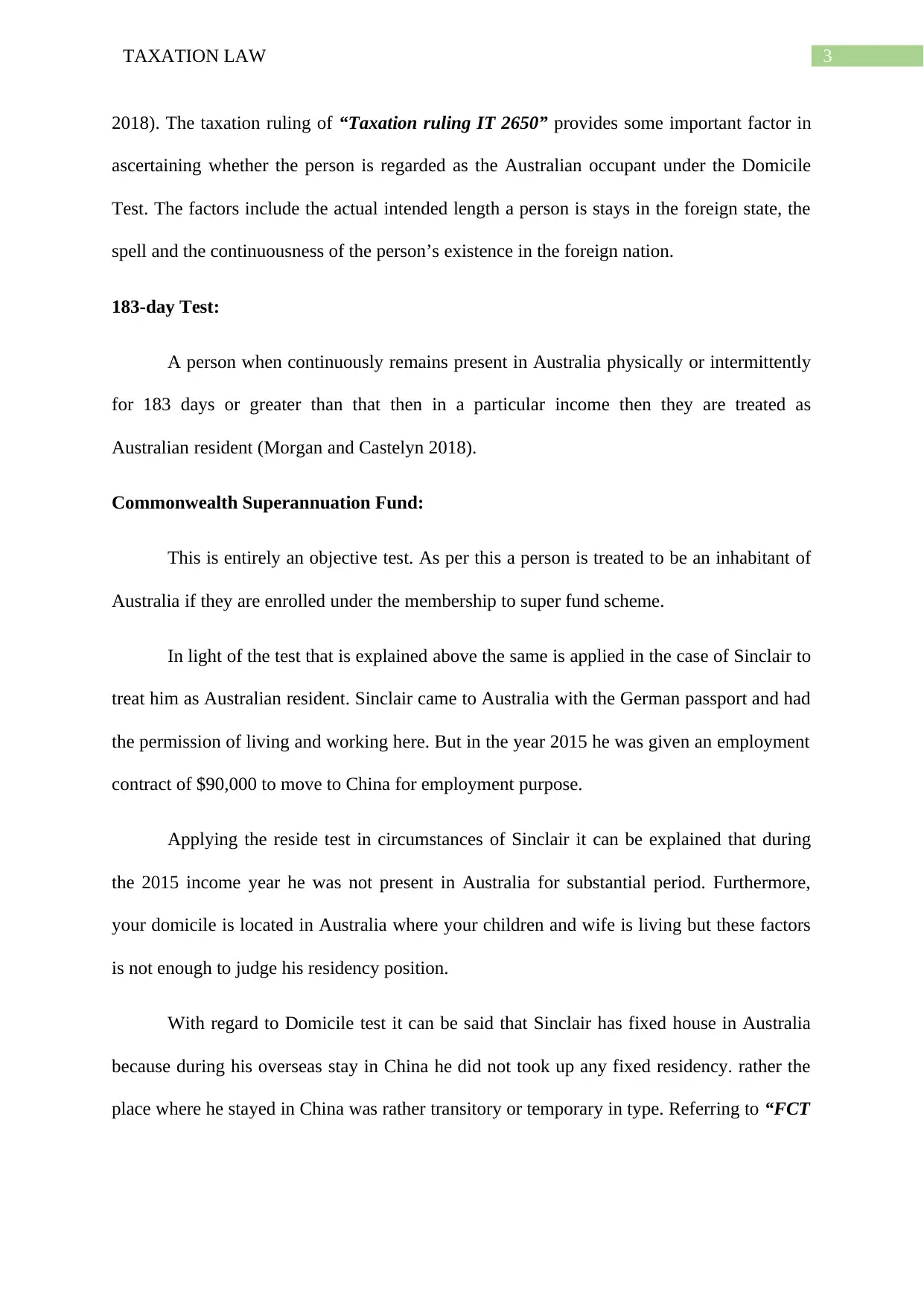
3TAXATION LAW
2018). The taxation ruling of “Taxation ruling IT 2650” provides some important factor in
ascertaining whether the person is regarded as the Australian occupant under the Domicile
Test. The factors include the actual intended length a person is stays in the foreign state, the
spell and the continuousness of the person’s existence in the foreign nation.
183-day Test:
A person when continuously remains present in Australia physically or intermittently
for 183 days or greater than that then in a particular income then they are treated as
Australian resident (Morgan and Castelyn 2018).
Commonwealth Superannuation Fund:
This is entirely an objective test. As per this a person is treated to be an inhabitant of
Australia if they are enrolled under the membership to super fund scheme.
In light of the test that is explained above the same is applied in the case of Sinclair to
treat him as Australian resident. Sinclair came to Australia with the German passport and had
the permission of living and working here. But in the year 2015 he was given an employment
contract of $90,000 to move to China for employment purpose.
Applying the reside test in circumstances of Sinclair it can be explained that during
the 2015 income year he was not present in Australia for substantial period. Furthermore,
your domicile is located in Australia where your children and wife is living but these factors
is not enough to judge his residency position.
With regard to Domicile test it can be said that Sinclair has fixed house in Australia
because during his overseas stay in China he did not took up any fixed residency. rather the
place where he stayed in China was rather transitory or temporary in type. Referring to “FCT
2018). The taxation ruling of “Taxation ruling IT 2650” provides some important factor in
ascertaining whether the person is regarded as the Australian occupant under the Domicile
Test. The factors include the actual intended length a person is stays in the foreign state, the
spell and the continuousness of the person’s existence in the foreign nation.
183-day Test:
A person when continuously remains present in Australia physically or intermittently
for 183 days or greater than that then in a particular income then they are treated as
Australian resident (Morgan and Castelyn 2018).
Commonwealth Superannuation Fund:
This is entirely an objective test. As per this a person is treated to be an inhabitant of
Australia if they are enrolled under the membership to super fund scheme.
In light of the test that is explained above the same is applied in the case of Sinclair to
treat him as Australian resident. Sinclair came to Australia with the German passport and had
the permission of living and working here. But in the year 2015 he was given an employment
contract of $90,000 to move to China for employment purpose.
Applying the reside test in circumstances of Sinclair it can be explained that during
the 2015 income year he was not present in Australia for substantial period. Furthermore,
your domicile is located in Australia where your children and wife is living but these factors
is not enough to judge his residency position.
With regard to Domicile test it can be said that Sinclair has fixed house in Australia
because during his overseas stay in China he did not took up any fixed residency. rather the
place where he stayed in China was rather transitory or temporary in type. Referring to “FCT
Paraphrase This Document
Need a fresh take? Get an instant paraphrase of this document with our AI Paraphraser
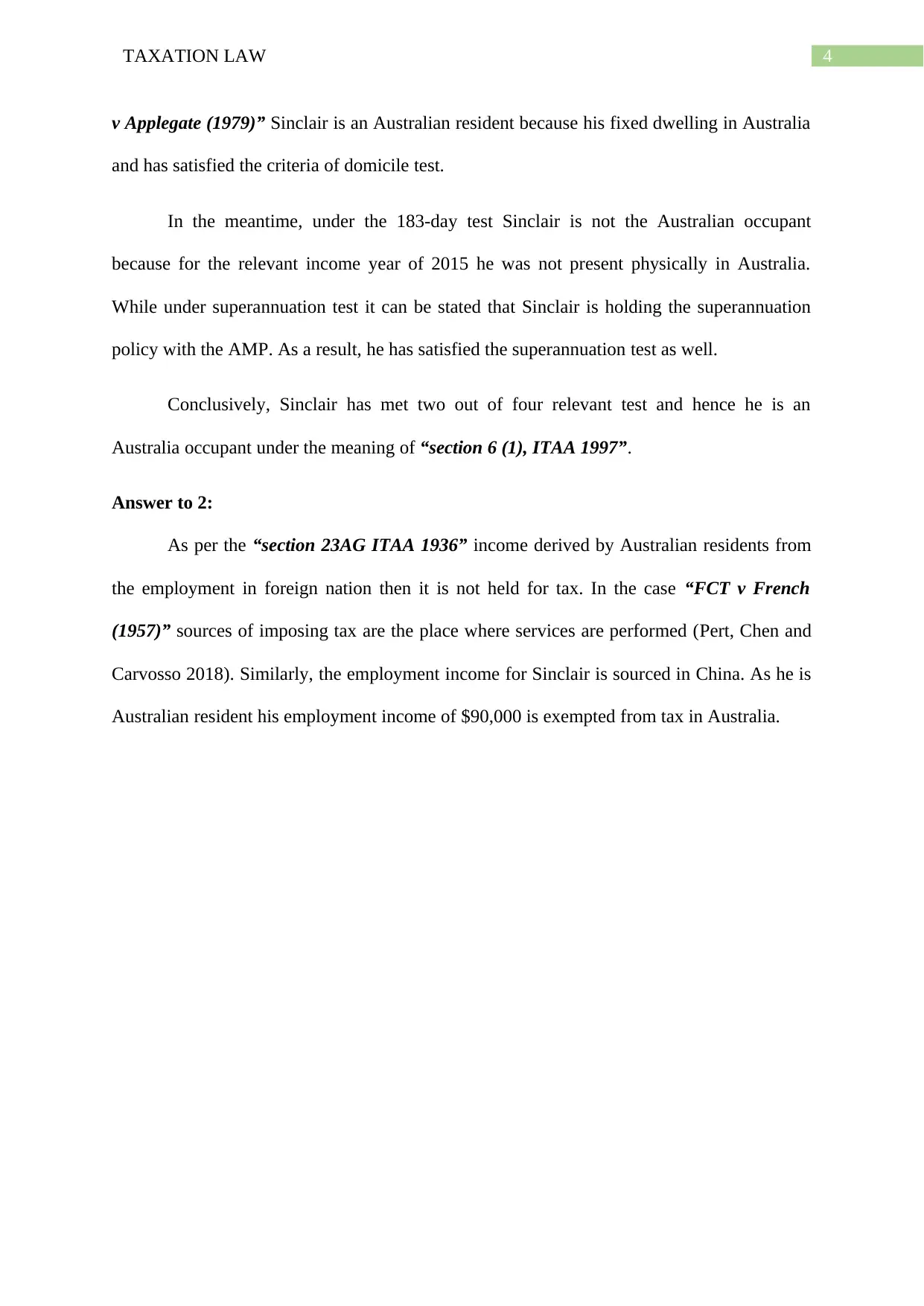
4TAXATION LAW
v Applegate (1979)” Sinclair is an Australian resident because his fixed dwelling in Australia
and has satisfied the criteria of domicile test.
In the meantime, under the 183-day test Sinclair is not the Australian occupant
because for the relevant income year of 2015 he was not present physically in Australia.
While under superannuation test it can be stated that Sinclair is holding the superannuation
policy with the AMP. As a result, he has satisfied the superannuation test as well.
Conclusively, Sinclair has met two out of four relevant test and hence he is an
Australia occupant under the meaning of “section 6 (1), ITAA 1997”.
Answer to 2:
As per the “section 23AG ITAA 1936” income derived by Australian residents from
the employment in foreign nation then it is not held for tax. In the case “FCT v French
(1957)” sources of imposing tax are the place where services are performed (Pert, Chen and
Carvosso 2018). Similarly, the employment income for Sinclair is sourced in China. As he is
Australian resident his employment income of $90,000 is exempted from tax in Australia.
v Applegate (1979)” Sinclair is an Australian resident because his fixed dwelling in Australia
and has satisfied the criteria of domicile test.
In the meantime, under the 183-day test Sinclair is not the Australian occupant
because for the relevant income year of 2015 he was not present physically in Australia.
While under superannuation test it can be stated that Sinclair is holding the superannuation
policy with the AMP. As a result, he has satisfied the superannuation test as well.
Conclusively, Sinclair has met two out of four relevant test and hence he is an
Australia occupant under the meaning of “section 6 (1), ITAA 1997”.
Answer to 2:
As per the “section 23AG ITAA 1936” income derived by Australian residents from
the employment in foreign nation then it is not held for tax. In the case “FCT v French
(1957)” sources of imposing tax are the place where services are performed (Pert, Chen and
Carvosso 2018). Similarly, the employment income for Sinclair is sourced in China. As he is
Australian resident his employment income of $90,000 is exempted from tax in Australia.
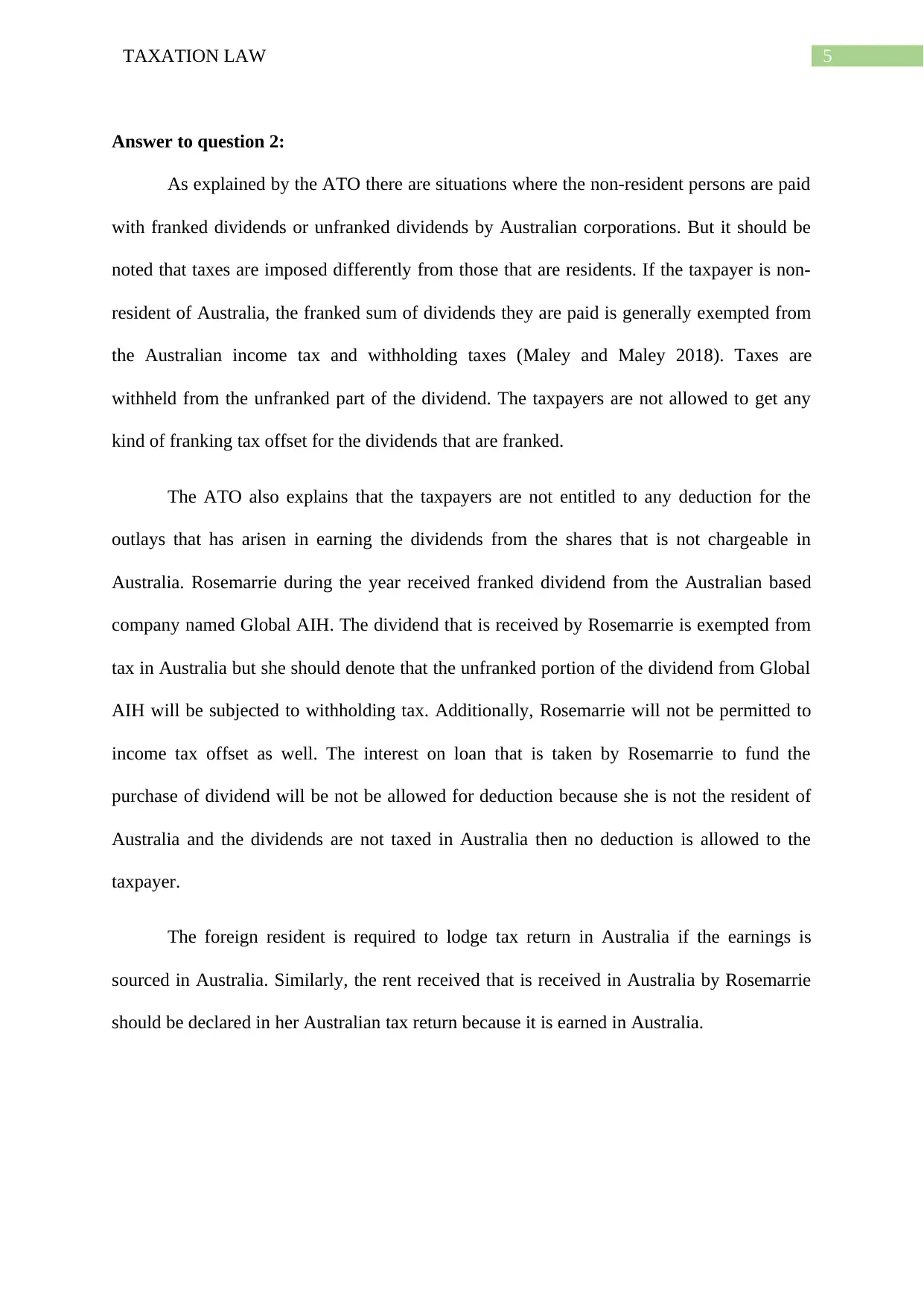
5TAXATION LAW
Answer to question 2:
As explained by the ATO there are situations where the non-resident persons are paid
with franked dividends or unfranked dividends by Australian corporations. But it should be
noted that taxes are imposed differently from those that are residents. If the taxpayer is non-
resident of Australia, the franked sum of dividends they are paid is generally exempted from
the Australian income tax and withholding taxes (Maley and Maley 2018). Taxes are
withheld from the unfranked part of the dividend. The taxpayers are not allowed to get any
kind of franking tax offset for the dividends that are franked.
The ATO also explains that the taxpayers are not entitled to any deduction for the
outlays that has arisen in earning the dividends from the shares that is not chargeable in
Australia. Rosemarrie during the year received franked dividend from the Australian based
company named Global AIH. The dividend that is received by Rosemarrie is exempted from
tax in Australia but she should denote that the unfranked portion of the dividend from Global
AIH will be subjected to withholding tax. Additionally, Rosemarrie will not be permitted to
income tax offset as well. The interest on loan that is taken by Rosemarrie to fund the
purchase of dividend will be not be allowed for deduction because she is not the resident of
Australia and the dividends are not taxed in Australia then no deduction is allowed to the
taxpayer.
The foreign resident is required to lodge tax return in Australia if the earnings is
sourced in Australia. Similarly, the rent received that is received in Australia by Rosemarrie
should be declared in her Australian tax return because it is earned in Australia.
Answer to question 2:
As explained by the ATO there are situations where the non-resident persons are paid
with franked dividends or unfranked dividends by Australian corporations. But it should be
noted that taxes are imposed differently from those that are residents. If the taxpayer is non-
resident of Australia, the franked sum of dividends they are paid is generally exempted from
the Australian income tax and withholding taxes (Maley and Maley 2018). Taxes are
withheld from the unfranked part of the dividend. The taxpayers are not allowed to get any
kind of franking tax offset for the dividends that are franked.
The ATO also explains that the taxpayers are not entitled to any deduction for the
outlays that has arisen in earning the dividends from the shares that is not chargeable in
Australia. Rosemarrie during the year received franked dividend from the Australian based
company named Global AIH. The dividend that is received by Rosemarrie is exempted from
tax in Australia but she should denote that the unfranked portion of the dividend from Global
AIH will be subjected to withholding tax. Additionally, Rosemarrie will not be permitted to
income tax offset as well. The interest on loan that is taken by Rosemarrie to fund the
purchase of dividend will be not be allowed for deduction because she is not the resident of
Australia and the dividends are not taxed in Australia then no deduction is allowed to the
taxpayer.
The foreign resident is required to lodge tax return in Australia if the earnings is
sourced in Australia. Similarly, the rent received that is received in Australia by Rosemarrie
should be declared in her Australian tax return because it is earned in Australia.
⊘ This is a preview!⊘
Do you want full access?
Subscribe today to unlock all pages.

Trusted by 1+ million students worldwide
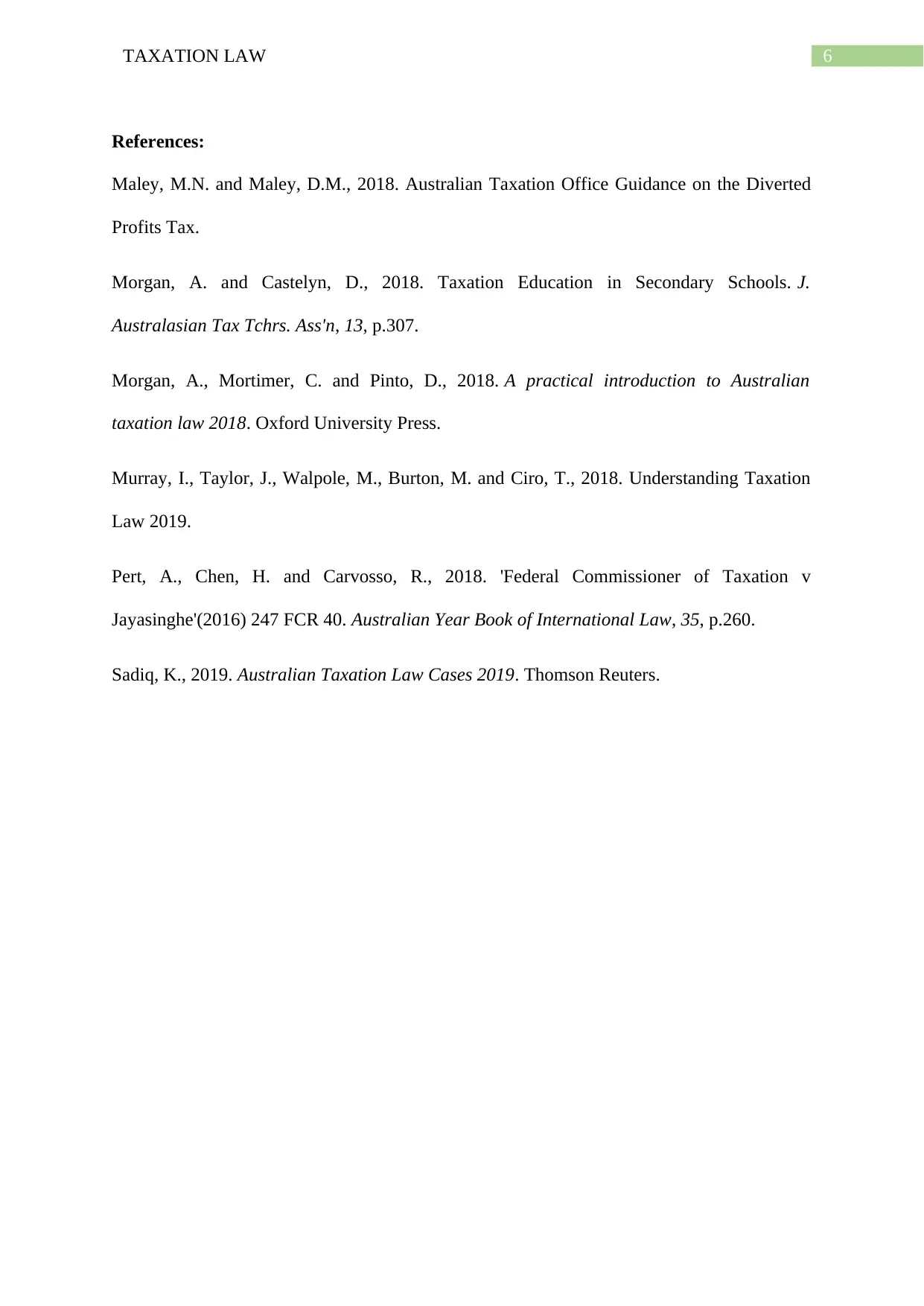
6TAXATION LAW
References:
Maley, M.N. and Maley, D.M., 2018. Australian Taxation Office Guidance on the Diverted
Profits Tax.
Morgan, A. and Castelyn, D., 2018. Taxation Education in Secondary Schools. J.
Australasian Tax Tchrs. Ass'n, 13, p.307.
Morgan, A., Mortimer, C. and Pinto, D., 2018. A practical introduction to Australian
taxation law 2018. Oxford University Press.
Murray, I., Taylor, J., Walpole, M., Burton, M. and Ciro, T., 2018. Understanding Taxation
Law 2019.
Pert, A., Chen, H. and Carvosso, R., 2018. 'Federal Commissioner of Taxation v
Jayasinghe'(2016) 247 FCR 40. Australian Year Book of International Law, 35, p.260.
Sadiq, K., 2019. Australian Taxation Law Cases 2019. Thomson Reuters.
References:
Maley, M.N. and Maley, D.M., 2018. Australian Taxation Office Guidance on the Diverted
Profits Tax.
Morgan, A. and Castelyn, D., 2018. Taxation Education in Secondary Schools. J.
Australasian Tax Tchrs. Ass'n, 13, p.307.
Morgan, A., Mortimer, C. and Pinto, D., 2018. A practical introduction to Australian
taxation law 2018. Oxford University Press.
Murray, I., Taylor, J., Walpole, M., Burton, M. and Ciro, T., 2018. Understanding Taxation
Law 2019.
Pert, A., Chen, H. and Carvosso, R., 2018. 'Federal Commissioner of Taxation v
Jayasinghe'(2016) 247 FCR 40. Australian Year Book of International Law, 35, p.260.
Sadiq, K., 2019. Australian Taxation Law Cases 2019. Thomson Reuters.
1 out of 7
Related Documents
Your All-in-One AI-Powered Toolkit for Academic Success.
+13062052269
info@desklib.com
Available 24*7 on WhatsApp / Email
![[object Object]](/_next/static/media/star-bottom.7253800d.svg)
Unlock your academic potential
Copyright © 2020–2025 A2Z Services. All Rights Reserved. Developed and managed by ZUCOL.





